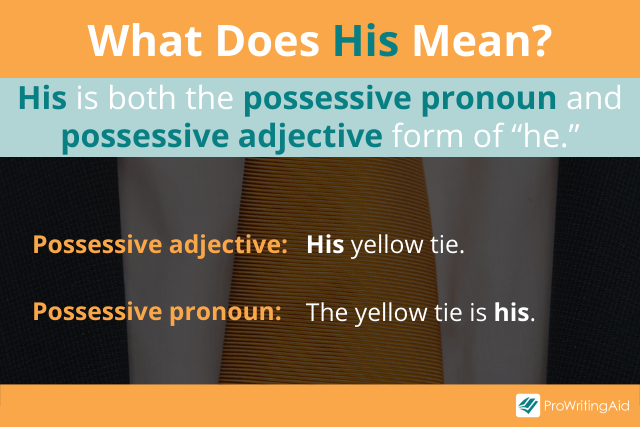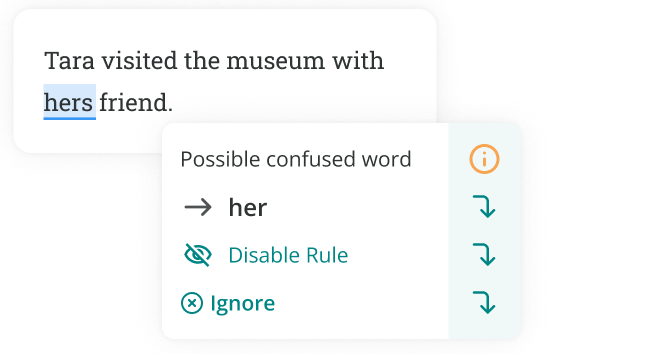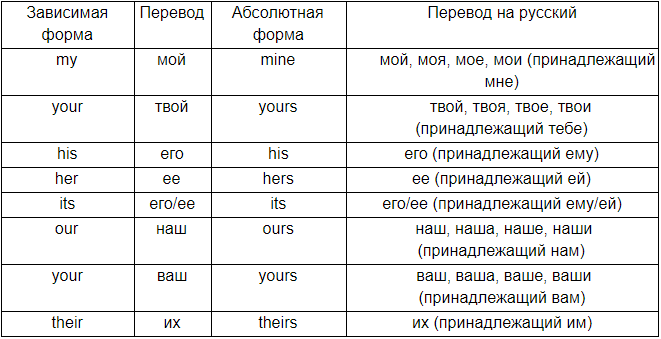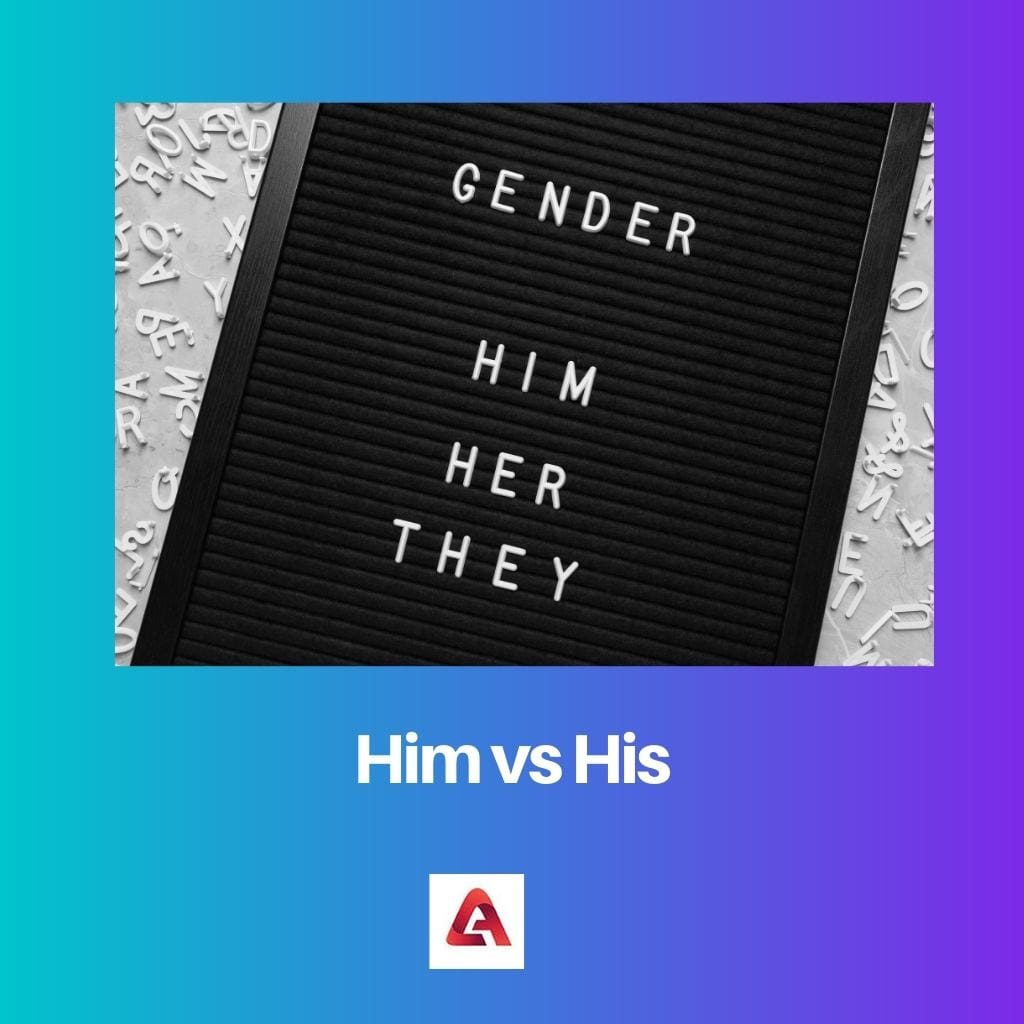English has quite a few pronouns, so it’s important to understand how to use them correctly.
His is a unique pronoun because it functions as both the possessive pronoun and possessive adjective form of “he.”
Let’s take a closer look at the definitions and meaning of his, and how to use this word in sentences.
His Definition
The word his has two closely related definitions, one for each part of speech. First, it means, “relating to him as a possessor.” In other words, it’s the possessive form of he and him and shows that something belongs to a male.
This part of speech is a determiner, which is a word that references a noun. Determiners that relate to a specific number and/or gender are called possessive adjectives.
As a possessive adjective, his functions like this:
- his brown coat
But his can also be a possessive pronoun, which means it can stand in for a noun without another noun following it. It means “something that belongs to him.”
Here’s what his looks like as a possessive pronoun:
- Which coat is his? The brown one.
- Which car is his? The black one with the dent.
His Meaning
The word origin of his dates back to Middle English, before the twelfth century. It comes from the word hē, which later became “he” without the pronunciation line—called a macron—above the E.
His is an interesting possessive form because it’s the only one that functions as both a possessive pronoun and possessive adjective.
For example, in the first-person, there are “my” and “mine.” The third-person singular female forms are “her” and “hers.”
But the word his is the same in both uses. We can say “his dog” or “the dog is his.”
His doesn’t have to refer to just a human male, either. It can also refer to a male animal, if you prefer not to use “it/its” for a creature.
For example, we could say, “That is his dog bed.” Or we could leave off the following noun and switch to the possessive pronoun: “The dog bed is his.”
Examples of His in Sentences
The best way to understand how to use a word is to read examples. Let’s take a look at some more examples of the word his, this time from famous books.
First, here are some examples of his as a possessive adjective.
“I wanted you to see what real courage is, instead of getting the idea that courage is a man with a gun in his hand. It’s when you know you’re licked before you begin but you begin anyway and you see it through no matter what. You rarely win, but sometimes you do.”—Harper Lee, To Kill a Mockingbird
“As Gregor Samsa awoke one morning from uneasy dreams he found himself transformed in his bed into an enormous insect.”—Franz Kafka, The Metamorphosis
“A man, after he has brushed off the dust and chips of his life, will have left only the hard, clean questions: Was it good or was it evil? Have I done well—or ill?”—John Steinbeck, East of Eden
Now, we can look at a couple of examples of his as a possessive pronoun.
“He’s more myself than I am. Whatever our souls are made of, his and mine are the same.”—Emily Brontë, Wuthering Heights
“Phaedra keeps saying she’s being selfish. That she hates herself for it, but she does it anyway. She can’t deny herself what she wants, even if it brings about her downfall and his.”—Cora Cormack, Losing It
Now you’ve learned everything there is to know about his. If you still struggle with pronouns, run your writing through our free grammar checker. We’ll check your pronoun usage so whatever you write is error-free.
Take your writing to the next level:
20 Editing Tips from Professional Writers
Whether you are writing a novel, essay, article, or email, good writing is an essential part of communicating your ideas.
This guide contains the 20 most important writing tips and techniques from a wide range of professional writers.

Главная — Справочник — Разница между Him и His
Wherever a man goes to dwell, his character goes with him.
Старая африканская поговорка
Современную версию этой нехитрой мысли вы наверняка встречали в широко известном высказывании английского писателя Нила Геймана. В одной из своих детских книг фантаст написал: «Они как те люди, которые думают, что будут счастливы, если переедут в другое место, а потом оказывается: куда бы ты ни поехал, ты берёшь с собой себя».
Wherever a man goes to dwell, his character goes with him. — Куда бы человек не отправился, его характер следует за ним.
Для нас крылатая фраза ценна не только, как пример поговорки, которую при случае можно употребить в разговоре с англоговорящим собеседником, но и как иллюстрация использования притяжательного прилагательного (possessive adjective) his и объектного местоимения (object pronoun) him.
В чем отличие между him и his?
В этой статье мы разберем понятия his и him, которые часто переводятся на русский язык одним словом «его», при этом обозначая разные вещи. Сравните:
I brought his jacket. — Я принес его куртку.
I called him. — Я позвал его.
В первом случае мы имеем притяжательное прилагательное his. Мы используем его, чтобы показать владение или родство.
Во втором случае перед нами объектное местоимение him. Мы используем его, чтобы обозначить объект, на который направлено действие.
Однако, прежде чем переходить к разбору различий между him и his, давайте вспомним, что такое личные местоимения. Ведь это база, на основе которой строятся все остальные формы.
Личные местоимения (Personal pronouns)
Как легко догадаться из названия, личные местоимения нужны нам для того, чтобы обозначить одушевленный или неодушевленный предмет. Личные местоимения бывают субъектные и объектные.
Субъектные местоимения употребляются в именительном падеже и отвечают на вопросы кто?, что?
He — субъектное местоимение (subject pronoun)
He — субъектное личное местоимение и означает слово «Он». Мы используем he как подлежащее (subject) в именительном падеже. Особенно полезно личное местоимение he бывает в ситуации, когда в предложении уже прозвучало имя человека, и мы не хотим повторять его несколько раз.
Brad Pitt is a great actor. He has been nominated for the Academy Awards several times. In 2020 he won an Oscar for his role in Once Upon a Time in Hollywood. — Брэд Питт — отличный актер. Он был номинирован на премию Американской Киноакадемии несколько раз. В 2020 году он получил Оскар за свою роль в «Однажды в Голливуде».
Him — объектное местоимение (object pronoun)
Him — объектное личное местоимение. Мы используем him как дополнение (object), отвечающее на вопросы кого?, кому?, кем?, о ком? Проще говоря, на вопросы всех падежей русского языка, кроме именительного.
He — он
Him — его/него, ему/нему, им/ним, о нём
Местоимение him не может быть подлежащим. Это всегда объект, на который направлено действие.
Yesterday Mary visited him at the hospital. — Вчера Мэри навестила его в больнице.
The teacher gave him a new book. — Учитель дал ему новую книгу.
I saw him the other day. — Я видел его на днях.
This article is written by him. — Эта статья написана им.
What do you know about him? — Что ты знаешь о нем?
His — притяжательное прилагательное (possessive adjective)
Притяжательные прилагательные указывают на принадлежность предмета к кому-либо или чему-либо, и отвечают на вопросы чей?, чья?, чье?, чьи?
Притяжательные прилагательные всегда располагаются перед существительным.
His eyes are blue. — Его глаза голубые.
I’m driving his car right now. — В данный момент я веду его машину.
His — притяжательное местоимение (possessive pronoun)
Притяжательные местоимения выполняют функцию существительных, а не прилагательных. При этом важно, чтобы из контекста было понятно, какое именно существительное они представляют. В отличие от других местоимений, которые меняются при переходе в эту форму, his остается his.
My coffee is hot. I can’t say the same about his. — Мой кофе горячий. Я не могу сказать то же самое о его.
My cat loves fish, while his prefers cucumbers. — Моя кошка любит рыбу, в то время как его предпочитает огурцы.
Очень часто притяжательное местоимение his используется, чтобы указать на принадлежность предмета.
Ben is a friend of his. — Бен его друг.
This t-shirt is his. — Эта футболка его.
Him vs His: как определить?
В этой статье мы разобрали, чем отличается объектное местоимение him от притяжательного прилагательного и притяжательного местоимения his. Научиться правильно использовать him и his нам поможет определение контекста и правильная постановка вопроса, на который местоимение должно отвечать: «кого? — его» и «чья? — его» — не одно и тоже, несмотря на то, что на русский язык переводятся одинаково.
Закрепим?
Вставьте him и his:
1. ______ mother always kisses ______ goodnight.
2. Every Sunday I have lunch with ______ and ______ wife.
3. This brooch has been handcrafted by ______.
4. A good friend of ______ invited me to the party.
5. I fell in love with ______ the moment my eyes met ______.
6. Two years ago I visited ______ in Italy.
7. That interview of ______ impressed me very much.
8. Barbara will take ______ to see the doctor.
9. My son likes to play basketball, while ______ prefers hockey.
10. What can ______ teacher tell us about ______?
1. His mother always kisses him goodnight.
2. Every Sunday I have lunch with him and his wife.
3. This brooch has been handcrafted by him.
4. A good friend of his invited me to the party.
5. I fell in love with him the moment my eyes met his.
6. Two years ago I visited him in Italy.
7. That interview of his impressed me very much.
8. Barbara will take him to see the doctor.
9. My son likes to play basketball, while his prefers hockey.
10. What can his teacher tell us about him?
Узнайте также в Справочнике
Обновлено: 25 июля 2022 года
The difference between his and him lies in the usage of each pronoun. His and Him are two case forms of the pronoun ‘he.’ So, both of these forms show some sort of difference between them in terms of their usage. The word his is the possessive or the genitive form of the pronoun ‘he.’ On the other hand, the word him is the objective form of the pronoun ‘he.’ This is the main difference between the two words, namely, his and him. As you can see, these two forms, his and him, have different purposes. So, as a result, the difference between each form is marked by this difference of purpose.
What does Him mean?
The form him is used as object in a sentence. In other words, him is an object pronoun. To be more specific, him is the object pronoun of the third person singular subject pronoun ‘he.’ You can identify an object by putting the question ‘ whom’ to the verb in the sentence. Take a look at the following sentences.
Mary asked him to be quiet.
Angela requested him to accompany her.
In the first sentence, the subject is Mary. That is because Mary is the person who did the action of asking. Then, who is the object? Object is the person who comes under the power of the subject. So, whom did Mary ask to be quiet? The answer is him. So, you can see that him is used as the object in this sentence.
If you look at the second sentence, there also him is used as the object. Angela is the subject. Requested is the verb of the sentence. So, whom did Angela request to accompany her? The answer is him. So, here also him is used as the object of the sentence.
‘Mary asked him to be quiet’
What does His mean?
On the other hand, the form his is used as a possessive pronoun or a possessive adjective of the subject pronoun he. It is used in the place of apostrophe as in the expression ‘Francis’ house’ or ‘his house.’ The word his refers to ‘Francis.’ So, the word his shows someone’s possession or ownership of something. Observe the two sentences given below.
Francis looked at his watch and exclaimed.
Lucy asked his friend to listen to him.
This box is his.
In all the sentences, you can see that the word his is used in the possessive case. In the first and second sentences, the word his is used as a possessive adjective. As a result, his comes before a noun. This shows that each object belongs to someone. In the second sentence, you can see that both his and him are used. Lucy is the subject. Him is the object pronoun. His is the possessive adjective. In the last sentence, the word his is used as the possessive pronoun of the subject pronoun he. When a word is used as a pronoun, you no longer have to make sure it comes before a noun. So, accordingly, here, the word his stands alone as it is the possessive pronoun.
It is interesting to note that both his and him are used only in the case of masculine nouns or pronouns.Their feminine counterparts are ‘her’ and ‘her’ respectively. It is important to know that the object and the possessive forms of feminine pronoun are one and the same. On the other hand, the possessive adjective and the possessive pronoun of the feminine pronoun are not one and the same. The possessive pronoun of she is hers.
‘Francis looked at his watch and exclaimed’
What is the difference between His and Him?
• Definition:
• Him is the object pronoun of the subject pronoun he.
• His is the possessive pronoun as well as the possessive adjective of the subject pronoun he.
• Placement:
• Him as an object pronoun comes after the verb.
• His as the possessive adjective comes before a noun.
• His as the possessive pronoun appears in the suitable place in the sentence, alone.
• Feminine Forms:
• Feminine of him is her.
• Feminine of his as a possessive adjective is her.
• Feminine form of his as a possessive pronoun is hers.
These are the differences between the two important pronominal forms in the English language, namely, his and him.
Images Courtesy:
- Shhh by catherine (CC BY 2.0)
- Watch via Pixabay (Public Domain)
What is a Pronoun?
A pronoun is defined as a word or phrase that is used as a substitution for a noun or noun phrase, which is known as the pronoun’s antecedent. Pronouns are short words and can do everything that nouns can do and are one of the building blocks of a sentence. Common pronouns are he, she, you, me, I, we, us, this, them, that. A pronoun can act as a subject, direct object, indirect object, object of the preposition, and more and takes the place of any person, place, animal or thing. So coffee becomes it, Barbara becomes she, Jeremy becomes he, the team becomes they, and in a sentence, Barbara drinks a cup of coffee every afternoon could become she drinks a cup of it every afternoon, or even she drinks it every afternoon, where the it would substitute the cup of coffee, not just the coffee.
Without pronouns, we’d constantly have to repeat nouns, and that would make our speech and writing repetitive, not to mention cumbersome. Without pronouns, Barbara drinks a cup of coffee every afternoon, she likes to have it before dinner would be Barbara drinks a cup of coffee every afternoon, Barbara likes to have the cup of coffee before dinner. Using pronouns helps the flow of sentences and makes them more interesting
- He
- It
- You
- I
- They
- We
- Who
- Him
- Them
- Whoever
- Anyone
- Something
- Nobody
Pronoun examples in the following sentences are in bold for easy identification.
- Billy, Caren, and I were playing poker with friends -> We were playing poker with friends.
- Ellie loves watching movies. -> She loves watching movies, especially if they are comedies.
- Will Daniel be going to the circus with Sarah? -> Will he be going there with her?
As mentioned, pronouns are usually used to replace nouns, however they can also stand in for certain adverbs, adjectives, and other pronouns. Almost anytime you refer to a person, animal, place or thing, you can use pronouns to add interest and make your speech or writing flow better.
In nearly all cases, a pronoun must follow an expression called an antecedent. This basically means that a pronoun can only really be understood in the context of prior information about the noun. For example, if we use the pronoun she in a sentence, we will only be able to understand it if we know who she is, thus an antecedent, perhaps giving the person’s name, is usually supplied first. In the example above Barbara drinks a cup of coffee every afternoon, if we had never mentioned Barbara or what she drinks, it would be unclear if we said, She drinks it every afternoon. Your reader would be confused and wonder who she is and what does she drink, wine, water, lemonade?
Once Barbara has been mentioned, we would use the pronouns she and her later in the writing in order to stop repeating the proper noun Barbara and possessive proper noun Barbara’s.
Barbara went to the restaurant for dinner with her (Barbara’s) friends. She (Barbara) was very hungry, but her (Barbara’s) friends would not stop chatting. Eventually, Barbara decided to take matters into her (Barbara’s) own hands and she (Barbara) demanded that they (Barbara’s friends) stop talking.
Imagine how that sentence would read if it kept repeating Barbara and Barbara’s. Pronouns have acted to make the writing tighter and, arguably, much more elegant. This is just a basic example of the use of pronouns, they act in many ways to help make speech and writing more lucid and dynamic.
Types of Pronouns
Pronouns can be divided into numerous categories including:
- Indefinite pronouns – those referring to one or more unspecified objects, beings, or places, such as someone, anybody, nothing. Notice in the examples below that there is no set position for where an indefinite pronoun will appear in a sentence.
Indefinite pronoun examples:
1. Anyone
2. Somebody
3. Whichever
4. Whoever
5. Other
6. Something
7. NobodyIndefinite pronoun examples in the following sentences are in bold for easy identification.
- Would anyone like a coffee?
- Take whatever you like. Jamie took one cookie and Ben took the other.
- Whoever owns this is in big trouble! I want someone to move this now.
Indefinite pronouns can also be used to create sentences that are almost abstract. Examples could include: this, all, such and something.
- All was not lost.
- Such is life.
- Something tells me this won’t end well.
- Personal pronouns – those associated with a certain person, thing, or group; all except you have distinct forms that indicate singular or plural number. Personal pronouns are always specific and are often used to replace a proper noun (someone’s name) or a collective group of people or things. Personal pronouns have two main groups, one referring to the subject of the sentence and one to the object.
The first is used to replace the subject of the sentence: I, you, he, she, it, we, you and they. Notice that you is repeated as you can be singular, addressing one person, or plural, addressing a group of people.Personal pronoun examples in the following sentences are in bold for easy identification.
- Jack and David are friends. They play basketball together.
- I have more money than he
- We will be late if you don’t hurry up.
The second group of pronouns replaces the object of the sentence: me, you, him, her, it, us, you, them. Consider the sentence again:
We will be late if you don’t hurry up.
In the above example, we is the subject of the sentence, but you is the object. Other examples of pronouns replacing the object:
- Peter sang the song to me.
- Missing the train will cause us to be late.
She packed them tightly in the suitcase.
- Reflexive pronouns – those preceded by the adverb, adjective, pronoun, or noun to which they refer, and ending in –self or –selves. Reflexive pronouns are used to refer back to the subject or clause of a sentence. The list of reflexive pronouns includes: Myself, yourself, himself, herself, itself, ourselves, yourselves, themselves.
Reflexive pronoun examples in the following sentences are in bold for easy identification.- Count yourselves
- Annie only had herself to blame.
Peter and Paul had baked themselves cakes.
- Demonstrative pronouns – those used to point to something specific within a sentence. There are only four demonstrative pronouns – this, that, these, those – but the usage can be a bit tricky at times. This and that are singular, whereas these and those are plural. As you may have noticed, there can be some crossover with indefinite pronouns when using this and that.
Demonstrative pronoun examples in the following sentences are in bold for easy identification.- I prefer this.
- These are beautiful, but those belong to Danny.
- Did you see that?
While it can be confusing, this, that, these and those can sometimes be used as demonstrative adjectives. The difference between the two is that a demonstrative pronoun replaces the noun and a demonstrative adjective qualifies the noun.
I prefer this photo. These flowers are beautiful, but those vases belong to Danny. Did you see that rainbow?
It should be clear that this, that, these and those in the example above are not pronouns because they are being used to qualify the noun, but not replace it. A good trick for remembering the difference is that a demonstrative pronoun would still make sense if the word one or ones followed it in the sentence.
I prefer this (one). These (ones) are beautiful. Did you see that (one)? Those (ones) belong to Danny.
- Possessive pronouns – those designating possession or ownership. Examples include: mine, its, hers, his, yours, ours, theirs, whose. Consider the example:
- This cat is mine.
Mine is indicating possession, that the cat belongs to me. Incidentally, this in the sentence is not a pronoun but demonstrative adjective as it qualifies the noun cat. You will find that possessive pronouns often follow phrases that contain demonstrative adjectives.
Possessive pronoun examples in the following sentences are in bold for easy identification.
- Are these bananas yours?
- This money is ours.
Is the fault theirs or yours?
- Relative pronouns –those which refer to nouns mentioned previously, acting to introduce an adjective (relative) clause. They will usually appear after a noun to help clarify the sentence or give extra information. Examples include: who, which, that, whom, whose. Consider the following sentence:
The man who stole the car went to jail. The relative pronoun who acts to refer back to the noun man. It acts to open a clause by identifying the man as not just any man, but the one who stole the car.Relative pronoun examples in the following sentences are in bold for easy identification.- The table, which sits in the hallway, is used for correspondence.
- The car that crashed into the wall was blue.
- This is the woman, whose key you found.
- Interrogative pronouns –Those which introduce a question. Examples include: who, whom, whose, what, which. We can usually identify an interrogative pronoun by the fact that they often appear at the beginning of a question.
Interrogative pronoun examples in the following sentences are in bold for easy identification.- Who will come to the party?
- Which do you prefer?
- What do you need?
- Whose clothes are on the floor?
- Whom did you tell?
Whom and who are often confused, and even native speakers will use them incorrectly. Who will replace the subject of a sentence, whereas whom will replace the direct or indirect object. A good tip for deciding which to use is that you can replace who in the sentence with a personal pronoun and it will still make sense. Who will come to the party? I will come to the party. The same system would not work for Whom did you tell? I did you tell.
- Reciprocal pronouns –Those expressing mutual actions or relationship; i.e. one another.
There are just two reciprocal pronouns in English: one another and each other. They are mainly used to stop unnecessary repetition in a sentence, but also to reinforce the idea that collective and reciprocal actions are happening to more than one person or thing.John and Mary gave each other gifts. Using each other allows us the sentence to be more efficient than: John gave Mary a gift and Mary gave a gift to John. The countries worked with one another on national security. In this example, one another works to suggest that the action of working is being reciprocated back and forth by more than one country.Reciprocal pronoun examples in the following sentences are in bold for easy identification.
- The boxers punched each other
The couple love one another deeply
- Intensive pronouns – those ending in –self or –selves and that serve to emphasize their antecedents. These are almost identical to reflexive pronouns, but rather than just referring back to the subject of the sentence they work to reinforce the action. In many cases, the sentence would still make sense without the intensive pronoun.
Intensive pronoun examples in the following sentences are in bold for easy identification.- I will do it myself.
- We made this pie ourselves.
- A nation speaks for itself through elections.
Notice how the intensive pronoun is working to emphasize the statement. The sentence would still technically be correct without the intensive pronoun, but it adds some important context to its meaning.
Pronoun Rules
There are a few important rules for using pronouns. As you read through these rules and the examples in the next section, notice how the pronoun rules are followed. Soon you’ll see that pronouns are easy to work with.
- Subject pronouns may be used to begin sentences. For example: We did a great job.
- Subject pronouns may also be used to rename the subject. For example: It was she who decided we should go to Hawaii.
- Indefinite pronouns don’t have antecedents. They are capable of standing on their own. For example: No one likes the sound of fingernails on a chalkboard.
- Object pronouns are used as direct objects, indirect objects, and objects of prepositions. These include: you, me, him, her, us, them, and it. For example: David talked to her about the mistake.
- Possessive pronouns show ownership. They do not need apostrophes. For example: The cat washed its
Examples of Pronouns
In the following examples, the pronouns are italicized.
- We are going on vacation.
- Don’t tell me that you can’t go with us.
- Anybody who says it won’t be fun has no clue what they are talking about.
- These are terribly steep stairs.
- We ran into each other at the mall.
- I’m not sure which is worse: rain or snow.
- It is one of the nicest Italian restaurants in town.
- Richard stared at himself in the mirror.
- The laundry isn’t going to do itself.
- Someone spilled orange juice all over the countertop!
Pronoun Exercises
The following exercises will help you gain greater understanding about how pronouns work. Choose the best answer to complete each sentence.
- This is __________ speaking.
- John
- He
- He john
- Am
- Greg is as smart as __________ is.
- I
- me
- she
- we
- The dog chewed on __________ favorite toy.
- it’s
- it is
- its’
- its
- It could have been __________ .
- Jerry
- anyone
- better
- more difficult
- Terry is taller than __________ am.
- I
- me
- she
- we
Answers
- B. This is he speaking.
- C. Greg is as smart as she is.
- D. The dog chewed on its favorite toy.
- B. It could have been anyone.
- A. Terry is taller than I am.
List of Pronouns
As you read through this list of pronouns, remember that each one of these pronouns is a word that can be used to take the place of a noun. Think about ways to use the pronouns on this list in sentences, as this will increase your understanding.
I
We
Me
Us
You
She
He
Her
Him
They
Them
It
That
Which
Who
Whom
Whose
Whichever
Whoever
Whomever
This
These
That
Those
Anybody
Anyone
Anything
Each
Either
Everyone
Everybody
Everything
Nobody
Neither
No one
Nothing
Somebody
One
Someone
Something
Few
Many
Both
Several
Any
All
Some
Most
None
Myself
Yourself
Ourselves
Yourselves
Herself
Himself
Themselves
Itself
Who
What
Which
Whose
Whom
Разница между his и him очевидна: his относится к притяжательным местоимениям, him — к объектным. Но чтобы понимать разницу между him и his при употреблении их в речи, нужно знать, к каким группам местоимений они относятся и какие функции выполняют в предложении.
Для начала обратимся к таблице местоимений в английском языке:
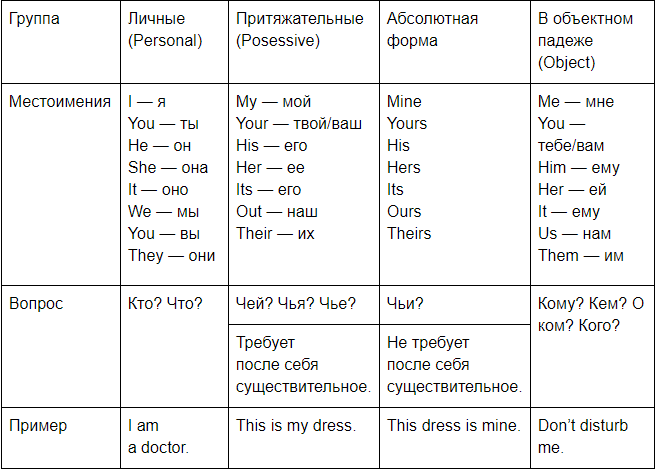
Объектные местоимения
Их главная отличительная особенность состоит в том, что они не могут являться подлежащим в английском предложении. Данный тип местоимений выполняет роль дополнения и никогда не отвечает на вопросы «кто?» и «что?». Объектные местоимения чаще всего отвечают на вопросы «кому?», «кем?», «о ком?» и «кого?».
Как правило, объектные местоимения следуют за глаголом либо предлогом. Они никогда не стоят на первом месте в предложении. Данные местоимения дополняют глагол, а не указывают на лицо, которое выполняет действие. Это правило относится, конечно, и к местоимению him — для понимания разницы между his и him.
Примеры употребления объектных местоимений:
- I don’t know what to tell him. — Я не знаю, что сказать ему.
- Lucy loved him very much. — Люси очень его любила.
- They didn’t want to listen to her. — Они не хотели слушать ее.
- When I entered the room, I saw her near the window. — Когда я вошел в комнату, я увидел ее возле окна.
- Where did you see them? — Где вы их видели?
- Open the window, please. — Wait a minute. I’ll write two more lines and then open it. — Открой окно, пожалуйста. — Подожди минуту. Я напишу еще две строчки и затем открою его.
В английском языке нередко встречаются предложения, содержащие в себе несколько объектных местоимений. Например:
- Tell me about her. — Расскажите мне о ней.
- It’s my book. Give it to me, please. — Это моя книга. Дай ее мне, пожалуйста.
- Ask him about it. — Спросите его об этом.
- Last time I saw them with her. — В прошлый раз я видел их с ней.
- He asked me to look at him. — Он попросил меня посмотреть на него.
- Let’s tell him to come with us. — Давайте скажем ему пойти с нами.
Притяжательные местоимения
Представители этой группы местоимений указывают на принадлежность определенному лицу и отвечают на вопрос «чей?». В русском языке они согласуются с существительным в числе, роде и падеже.
В английском языке существует две формы местоимений этой группы: непосредственно притяжательные местоимения (possessive pronouns) и притяжательные прилагательные (possessive adjectives). Все они отличаются друг от друга, за исключением his: формы his имеют одинаковое написание, но выполняют в предложении разные смысловые функции. Для понимания разницы между his и him, разберем их подробнее.
Притяжательные прилагательные (Possessive Adjectives)
Употребляются только в связке с существительным и всегда стоят перед ним. В предложении они выполняют роль определения.
Перечень притяжательных местоимений (Possessive Adjectives):
- My — мой
- Your — твой
- His — его
- Her — ее
- Its — его/ее (для предметов и животных)
- Our — наш
- Your — твой
- Their — их
Примеры предложений с притяжательными прилагательными (Possessive Adjectives):
- My shirt is green. And your shirt is yellow. — Моя рубашка зелёная. А твоя рубашка — желтая.
- This is your book. It is on your table. — Это твоя книга. Она на твоем столе.
- Give me his address and his telephone number. — Дай мне его адрес и номер телефона.
- Do you know her address? I forgot where she lives. — Ты знаешь ее адрес? Я забыл, где она живет.
- Look at this dog. Its head is big. — Посмотрите на эту собаку. Ее голова большая.
- Our parents live in Italy. Sometimes we stay at their house. — Наши родители живут в Италии. Иногда мы останавливаемся в их доме.
Притяжательные местоимения (Possessive Pronouns)
Их называют также абсолютной или независимой формой притяжательных местоимений. После этих местоимений существительные никогда не ставятся, поскольку они сами употребляются вместо существительных. Они выполняют в предложении функцию подлежащего, дополнения или именной части сказуемого.
Перечень притяжательных местоимений (Possessive Pronouns):
- Mine — мой, моя, мое, мои
- Yours — твой, твоя, твоё, твои
- His — его
- Hers — ее
- Its — его/ее ( для предметов и животных)
- Ours — наш, наша, наше, наши
- Yours — ваш, ваша, ваше, ваши
- Theirs — их
Английские притяжательные местоимения в абсолютной форме заменяют в речи притяжательное прилагательное (Possessive Adjective) с существительным, чтобы избежать повторения информации. Например:
This book is my book, not your book. — Эта книга — моя книга, а не твоя книга.
This book is mine, not yours. — Эта книга моя, а не твоя.
Другие примеры предложений с притяжательными местоимениями:
- What’s mine is yours, my friend. — Что мое, то твое, друг мой.
- I broke my pencil. Please, give me yours. — Я сломал свой карандаш. Пожалуйста, дайте мне ваш.
- Are those gloves hers? — Те перчатки её?
- All the essays were good but his was the best. — Все сочинения были хорошие, но его было лучшее.
- Your photos are good. Ours are terrible. — Ваши фото отличные, а наши — ужасные.
- These aren’t John and Mary’s children. Theirs have black hair. — Это не дети Джона и Мэри. Их — черноволосые.
- John found his passport but Mary couldn’t find hers. — Джон нашел свой паспорт, а Мэри не могла найти свой.
- Is that chair yours? — Тот стул ваш?
- I know this drink is yours but I need to drink something. — Я знаю, что этот напиток ваш, но мне нужно что-то выпить.
Сравнительная таблица притяжательных прилагательных и притяжательных местоимений:
Итоги
Разница между his и him состоит в том, что они относятся к разным группам местоимений. Him — объектное местоимение, his — притяжательное местоимение.
Чтобы определить, что употреблять в конкретном случае, нужно понять:
- Какое существительное заменяет местоимение.
- Какую функцию это местоимение выполняет в предложении.
Форма притяжательного местоимения his совпадает с притяжательным прилагательным, но их функции различаются. Притяжательное прилагательное ставится перед существительным, к которому относится, оно не заменяют его полностью, как притяжательное местоимение. Например,
I haven’t seen him today. — Я не видел его сегодня («him» является дополнением, объектом в предложении).
Those shoes look like his. — Эти туфли похожи на его («his» здесь — притяжательное местоимение).
Joe forgot to bring his backpack to school today. — Джо забыл принести его (свой) ранец сегодня в школу («his» здесь — притяжательное прилагательное).
- Albanian: tij (sq)
- American Sign Language: FlatB@Chesthigh-FingerUp
- Arabic: ـهُ (ar) (-hu), (possessive pronoun) لَه (lah)
- Egyptian Arabic: ـه (-u), (Possessive Pronoun) ليه (li) بتاعو m (betaʿo) بتاعتو f (betaʿto) بتوعو pl (betoʿo)
- Armenian: նրա (hy) (nra)
- Old Armenian: նորա (nora)
- Aromanian: seu, (a) lui
- Asturian: so (ast)
- Bahamian Creole: he own
- Belarusian: яго́ (jahó), (common, colloquial) яго́ны (jahóny), (own, generic) свой (svoj)
- Bikol Central: saiya (bcl) (before a noun); niya (bcl) (after a noun)
- Breton: e (br)
- Bulgarian: не́гов (négov), свой (svoj) (own, generic)
- Burmese: သူ့ (su.)
- Catalan: seu (ca)
- Chinese:
- Mandarin: 他的 (zh) (tā de)
- Coptic: ⲡⲉϥ m (pef), ⲧⲉϥ f (tef), ⲛⲉϥ m pl or f pl (nef)
- Czech: jeho (cs), svůj (cs) (own, generic)
- Danish: hans (da)
- Dutch: zijn (nl) m
- Egyptian:
(.f)
- Esperanto: lia (eo)
- Estonian: tema (et), ta (et)
- Finnish: hänen (fi)
- French: son (fr) m, sa (fr) f, ses (fr) pl
- Friulian: so, sô
- Galician: seu (gl) m, súa f, seus m pl, súas f pl
- German: sein (de) m, n, seine (de) f, seine (de) pl
- Alemannic German: siin m, sini f, siis n
- Gothic: 𐍃𐌴𐌹𐌽𐍃 (seins)
- Greek: του (el) m (tou)
- Ancient: (genitive of personal pronoun) αὐτοῦ (autoû); (medial, proximal, distal demonstrative) τούτου (toútou), τοῦδε (toûde), ἐκείνου (ekeínou); (Epic demonstrative) τοῦ (toû); (Epic possessive adjective) ὅς (hós), ἑός (heós)
- Greenlandic: uuma
- Hawaiian: kona, kāna
- Hebrew: שלו (he) (shello)
- Hindi: उसका (uskā), इसका (iskā), उनका (hi) (unkā) (formal)
- Hungarian: -a (hu), -e (hu), -ja, -je
- Ido: ilua (io)
- Interlingua: su
- Irish: a (ga)
- Italian: suo (it) m, sua (it) f, suoi (it) pl, sue (it) f pl
- Japanese: 彼の (ja) (かれの, kare no)
- Kalmyk: энүнә (enünä), терүнә (terünä)
- Korean: 그의 (ko) (geuui)
- Kurdish:
- Northern Kurdish: wî (ku)
- Kyrgyz: анын (ky) (anın)
- Latin: suus (la), eius (la), illius
- Latvian: viņa (lv)
- Lithuanian: savas
- Louisiana Creole French: sô m, sâ f, sê pl
- Lower Sorbian: jogo
- Luxembourgish: säi, senger
- Macedonian: негов (negov), свој (svoj) (own, generic)
- Maltese: tiegħu, tagħhom pl
- Maori: tāna (singular dominant), tōna (singular subordiante), āna (plural dominant), ōna (plural subordinate), tana (singular neutral and informal), ana (plural neutral or informal)
- Navajo: bi-
- Ngarrindjeri: kinauwe
- Norwegian: hans (no), sin (no) (own, generic)
- Nyunga: balup
- Occitan: seu (oc), seuna (oc)
- Ojibwe: o-
- Oriya: ତାର (or) (tarô)
- Persian: او (fa) (u)
- Pipil: i-
- Polish: jego (pl), swój (pl)
- Portuguese: seu (pt)
- Romani: lesqo m, lesqi f, lesqe pl
- Romanian: său (ro) m, sa f, săi pl, sale (ro) f pl, lui (ro)
- Romansch: ses, sia
- Russian: его́ (ru) (jevó), свой (ru) (svoj) (own, generic)
- Scottish Gaelic: a
- Serbo-Croatian:
- Cyrillic: њѐгов, сво̑ј (own, generic)
- Roman: njègov, svȏj (sh) (own, generic)
- Slovak: jeho (sk), svoj (own, generic)
- Slovene: njegôv (sl), svój (own, generic)
- Spanish: su (es) sg, sus (es) pl
- Swedish: hans (sv), (reflexive) sin (sv)
- Telugu: (informal) వాడి (te) (vāḍi), అతని (atani), (formal) ఆయన (te) (āyana)
- Thai: ของเขา (kɔ̌ɔng kǎo)
- Tigrinya: ናቱ m (natu)
- Tlingit: du
- Turkish: onun (tr)
- Ukrainian: його́ (uk) (johó), свій (uk) (svij) (own, generic)
- Upper Sorbian: jeho
- Urdu: اس کا (us ka, is ka), (formal) ان کا (un ka)
- Vietnamese: của anh ấy, của nó, của hắn
- Volapük: omik (vo)
- Waray-Waray: iya,ira pl
- West Frisian: syn (fy)
- Zulu: possessive concord + -khe class 1 (most common), -wo class 3, -lo class 5, -so class 7, -yo class 9, -lo class 11
There are different types of pronouns, such as Personal, Indefinite, Possessive, Relative, Intensive, Reciprocal, Interrogative, Demonstrative, and Reflexive. They each have their subtypes, of which the word ‘HIM’ is.
It is an objective (subtype of personal) pronoun. Another one is ‘HIS,’ which is a possessive pronoun.
They have existed since old English. Back then, ‘Him’ is used to known as hym, heom, eom, and ‘His’ used to be called as, his, its, hit, etc.
Both the terms are third-person pronouns, which means they are used to talk about or referred to the person that is apart from the spokesperson and listener or is not around. We refer, that person with He, him or his.
Plenty of people assume Him and His are the two same concepts that appear in the place of ‘he.’ Although they represent masculine nouns, they have a variety of use in English Grammer.
Key Takeaways
- “Him” is a pronoun that represents the object of a verb or preposition, while “His” is a possessive pronoun that shows ownership.
- “Him” is an indirect or direct object, whereas “His” is an adjective to show possession.
- “Him” is always used as an object, while “His” indicates ownership.
“Him” is a pronoun used as the object of a verb or preposition, used to refer to a male person or animal that is the object of an action. “His” is a possessive determiner indicating ownership or possession, used to indicate ownership or possession of something by a male person or animal.
Want to save this article for later? Click the heart in the bottom right corner to save to your own articles box!
Comparison Table
| Parameter of Comparison | Him | His |
|---|---|---|
| Meaning | Him is an objective pronoun used in a sentence with reference to masculine noun for its quick recognition. | His is a possessive pronoun and a possessive adjective used in a sentence with reference of something that associates to the masculine noun. |
| Part of speech | It appears in a sentence after the verb. | Its possessive pronoun appears wherever it is suitable in a sentence. The possessive adjective appears before noun. |
| Use in Grammar | It is related to the object of the third person. | It is related to the possession of third person. |
| Relation to ‘He’ | Him is used in the replacement of the object of ‘He.’ | His is used before something that is owned by ‘He.’ |
| Alternative Terms | ‘Hym,’ ‘ym,’ ‘hyme,’ ‘hime,’ ‘im,’ ‘himm,’ and ‘hem’ are the alternative terms for ‘Him.’ | ‘Hys,’ ‘ys,’ ‘hise,’ ‘is,’ ‘hies,’ ‘es,’ ‘hes,’ and ‘as’ are the alternative terms for ‘His.’ |
| Type of Pronoun | It is an Objective Pronoun (personal). | It is a Possessive Pronoun. |
| Type of Adjective | It is not an adjective. | It is a possessive adjective. |
| Sample sentence | That emotional movie made him cry. | It is his own guitar. |
| Sample Paragraph | Sudeep is a responsible guy; I know him since school. It will be easy to work with him. | Sudeep is a responsible guy; he knows his responsibilities. It is his quality. |
| Feminine pronouns | Its feminine pronoun is Her. | Its feminine pronoun can be Her or Hers. |
What is Him?
Him is an objective pronoun used in a sentence concerning masculine noun for its quick recognition. It is a third-person pronoun. The masculine term is used in the replacement of the noun of ‘He.’
In grammar, it appears after the verb in a sentence. Its alternative terms are hym, ym, hyme, hime, im, himm, and hem. Its feminine pronoun is ‘Her.’
For example:
- Masculine – That amusing song made him laugh.
- Feminine – That amusing song made her laugh.
The word HIM with different meanings:
In Medical, it is an abbreviation of ‘Health Information Management.’ In Television, it is an animated TV series villain character of ‘The Powerpuff Girls.’ In Music, a very famous Finnish Gothic rock music band.
What is His?
His is a possessive pronoun and a possessive adjective used in a sentence with reference of something that associates to the masculine noun. It is a third person pronoun. The masculine term is used in the place of possession of the noun of ‘He.’
In grammar, it appears before the noun if it’s a possessive adjective. And if it is a possessive pronoun then it appears wherever it is suitable in a sentence. Its alternative terms are hys, ys, hise, is, hies, es, hes and as. The feminine pronoun of it is ‘Hers’ and the adjective is ‘Her.’
For example:
In possessive pronoun-
- Masculine – That is his song list.
- Feminine – That is hers song list.
In possessive adjective-
- Masculine – It’s his favorite song list.
- Feminine – It’s her favorite song list.
The word HIS with different meanings:
In Medical, it is a Japanese Travel Agency. In computing, it’s a short form of a Hong Kong graphics card company called ‘Hightech Information System.’
Main Differences Between Him and His
- An objective pronoun used in a sentence with reference to a masculine noun for its quick recognition is called as ‘Him.’ And when a possessive pronoun or a possessive adjective is used in a sentence with reference to something that associates with the masculine noun is known as ‘His.’
- The first term is filled after the verb, and the second one is before the noun or wherever it is suitable in the sentence.
- The term ‘him’ is used in the place of a third-person’ noun, whereas ‘his’ is used to refer to the third person’s possession.
- Replacement of the object of He is Him; on the contrary, its possession is His.
- Him is an objective pronoun; on the other hand, His is a possessive pronoun.
- Him is not an adjective, and His is an adjective.
- Example: Him – The one with the books was him, His – His eyes were speaking for himself.
References
- https://www.sciencedirect.com/science/article/pii/S0749596X03000718
- https://www.hkep.com/_v3/userfiles/book/sample/9789881901576s.pdf
- https://www.sciencedirect.com/science/article/pii/0024384178900062
Emma Smith holds an MA degree in English from Irvine Valley College. She has been a Journalist since 2002, writing articles on the English language, Sports, and Law. Read more about me on her bio page.
We know his can be used as pronoun and as determiner. But i am confused about how to decide whether it used as determiner or pronoun
for example
he said that john was his father
Is «his» a pronoun or a determiner here?
asked Apr 17, 2017 at 13:45
beginnerbeginner
5411 gold badge5 silver badges16 bronze badges
6
Pronouns take the place of a noun.
So if you see his immediately followed by a noun, it’s very likely a determiner, because two nouns in a row without a conjunction doesn’t work.
Also if you can replace his with an article, such as a/an or the, and the sentence still makes sense, it’s a determiner.
answered Apr 17, 2017 at 16:22
LawrenceCLawrenceC
36.4k25 silver badges77 bronze badges
2
I think it is both. It is a pronoun because it replaces a noun phrase:
- [Andrew’s] father > [his] father
- [the boy’s] father > [his] father
It fills the determiner/determinative slot in the syntax of the sentence: it cannot be used with an article like «the» or «a»:
- *the his father
- *a his father
So «his» could also be said to belong to the word class or part of speech «determiner/determinative.»
However, if you have to say one or the other, I would go with pronoun, since it is already a rule in English syntax that noun phrases (when put into the -‘(s)-genitive construction) can play the determiner/determinative syntactic role.
(Some sources use «determiner» for the function and «determinative» for the word class, other sources use «determinative» for the function and «determiner» for the word class.)
answered Apr 17, 2017 at 17:43
sumelicsumelic
6,7612 gold badges17 silver badges31 bronze badges
2
You must log in to answer this question.
Not the answer you’re looking for? Browse other questions tagged
.
Not the answer you’re looking for? Browse other questions tagged
.


